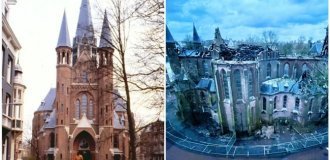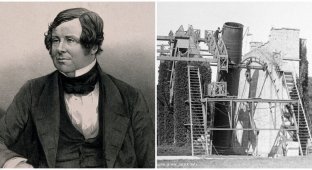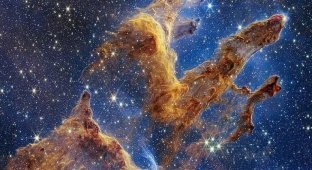Parsonstown Leviathan: a giant 12-ton telescope of the 19th century (4 photos)
Approximately 200 years ago, a dispute arose among astronomers. Them colleague Charles Messier was not too lazy to make a list of more than a hundred objects that looked fuzzy in his telescope. What happened in result? The best catalog of nebulae at that time. 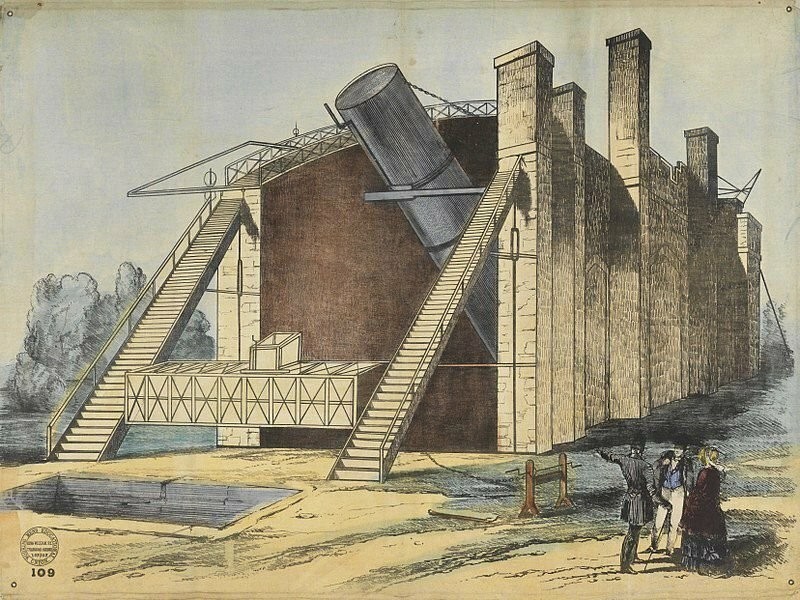
Parsonstown Leviathan
Scientists excitedly began to discuss a very simple question: “What is it all about? Clusters of thousands of stars that are impossible considered separately or clouds of gas? The only way to put an end to the discussion was obvious - to build a very large telescope and see objects better. And one appeared - "Leviathan Parsonstown". It was a real giant, reminiscent from the side fortress.
The telescope was erected on the grounds of Birr Castle in Ireland, residence of William Parsons. By education, this man was mathematician, but almost all his life he was involved in politics. Throwing this job in thirties of the XIX century, he returned to the family estate, where he dedicated themselves in the construction of means of observing outer space.
In 1841, Parsons succeeded his father as Earl of Ross, and along with it is in good condition. This made it possible to reach construction of an unprecedented telescope that would help resolve the dispute over nature of the Messier nebulae. Another thing is that it was to implement the plan incredibly difficult.
At that time, the diameter of the mirror of the largest telescope was only 1.2 meters. Parsons intended to increase this parameter immediately by 60 cm - this would allow to capture twice as much light. In our time, these structural elements are made of glass coated with one side with a thin layer of aluminum, but in the 19th century for this purpose bronze alloy was used. He had an excellent reflective ability, and it worked well. However, in order to do a mirror of the intended diameter, it was necessary to melt 4 tons of metal, and then cool the resulting workpiece. The second process, depending on various conditions, took from several weeks to four months. 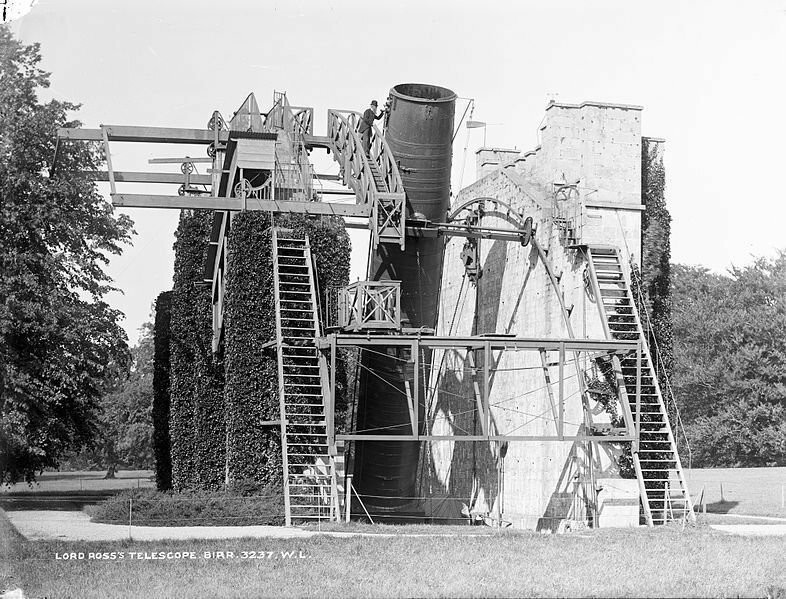
Parsonstown Leviathan
In order for a mirror to focus light properly, it needs form a perfect parabolic curve. Traditionally this was done by hand, but Parsons, inspired by the achievements of the Industrial Revolution, brought to work a steam engine that spun the workpiece under iron grinding tool.
Even with this innovation, polishing the huge mirror took two months and required five attempts. Then it all started all over again like a telescope needed two reflective work surfaces. The fact, that the bronze was rapidly tarnishing, and to ensure continuity observations of space, the mirrors had to be alternated.
But this was only the first part of a grandiose project. Parsons and the engineers hired by him had to build a wooden pipe 18 meters long. At one end, it was attached to the ground and moved along the vertical axis. using a complex system of pulleys that weighed no less than 150 tons. On the sides, the bulky structure had to be supported by two thick stone walls. Not surprisingly, this monster began to be called "Leviathan".
The durable outer "shell" coped admirably with its direct task, but it was also the most serious constructive lack of a telescope. The pipe moved up and down almost under any angle, but the walls prevented her from turning left or right. In order to view the desired part of the sky, one had to wait until the required direction will turn the Earth.
When it did happen, five people got involved. maintenance personnel - by manipulating the pulleys, they tried to keep an object in Leviathan's field of vision until our ever-rotating planet turned even further.
Space observation was also not the easiest thing to do. Photography was then in its infancy, so astronomers I had to consider everything with my own eyes, standing in a small cage at the top end of the telescope tube. Observation results sketched on paper - this work was made a little easier on purpose mounted easel. 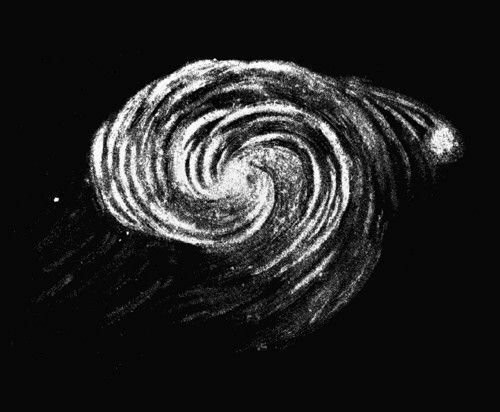
Drawing of the galaxy M51 made by Ulm Parsons in 1845 based on observations with the Leviathan
According to the description, all this looks extremely primitive, however, Parsons, and other scientists who have been fortunate enough to work with the giant telescope, apparently, turned out to be very good artists. Their sketches helped answer tormentingthe question of nebulae, and produced revolution in astronomy.
In 1845, just a month after the start of observations, Parsons presented a sketch of the Messier 51 nebula: a spiral, inside which individual stars were identified. The scientist was convinced that these luminaries moving together as one. He turned out to be absolutely right, because the sketch was nothing more than an image of another galaxy.
Over time, Parsons, his son, and their assistants identified 57 "spiral nebulae", of which 48 turned out to be galaxies. But this people also succeeded in definitively proving that other objects discovered by Messier are not formed by stars, but by brightly glowing gas. That is, in this case an extremely rare event for science occurred, when two groups of specialists, radically diverging in opinion, turned out to be equally right. 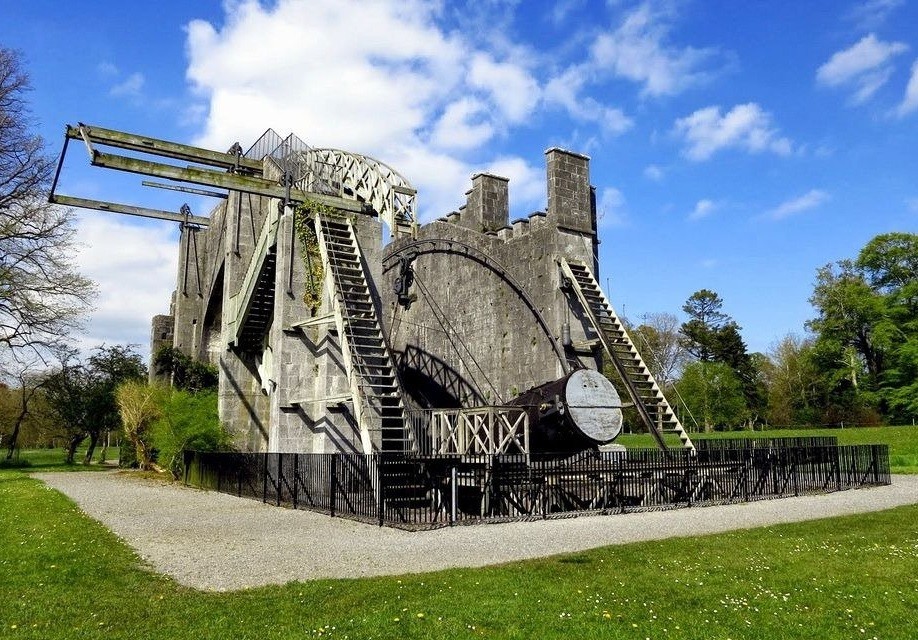
Modern view of Leviathan
Today Leviathan is a museum exhibit. Its time active service for the benefit of science ended long ago in the 80s of the XIX century. AT 1917 at the Mount Wilson Observatory in California, breaking the record of its predecessor, put into operation a telescope with a mirror 2.5 meters in diameter. However, the engineering creation of Count Ross forever inscribed itself in the history of astronomy. Parsonstown Leviathan helped resolve a fundamental scientific dispute and showed that the universe is much more and more interesting than it seemed before.











